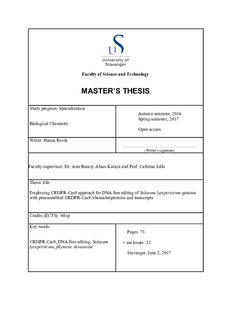| dc.description.abstract | In recent years there has been an increase in new demands in the agriculture sector due to factors as an increasing population, climate changes and food supplies. Hence, producing more food on less space has become a huge industry. Development of new and more acceptable technologies for editing genomes of plants is under scope in order to preserve the environment while maintaining global and local regulations.
There are four genome-editing methods that are highly used: meganucleases, zinc finger nucleases (ZFNs), transcription activator-like effector nucleases (TALENs) and the clustered regularly interspaced short palindromic repeat (CRISPR)-associated protein9 (Cas9). Several studies have shown that the CRISPR/Cas9 method has overcome other programmable nucleases techniques such as ZFNs and TALENs. The CRISPR/Cas9 system is based on a natural immune system found in bacteria and archaea that uses short ribonucleic acid (RNA) to direct degradation of foreign nucleic acids.
Deoxyribonucleic acid (DNA)-free editing of tomato genome could be of great value for agriculture. In this study, the aim was to investigate the ability to produce a DNA-free genetically modified organism (GMO), tomato, using CRISPR/Cas9 method. To achieve this, components needed to perform genome editing in tomato protoplasts was delivered, from which plants can be re-generated using the totipotency of plant cell. Two spacers were subcloned (20 bp; that can target the tomato reference gene; phytoene desaturase (PDS)) in order to prepare two single guide RNAs (sgRNAs) encoding genes.
Transcripts from sgRNAs and Cas9 were generated using in vitro transcription. To approve the setup, Cas9 protein and sgRNAs was combined in vitro and showed the ability of Cas9 protein to target and hence digest the PDS PCR product. To be able to perform these steps in vivo, editing with the low number of survived protoplasts using sgRNAs combined with Cas9 transcripts was attempted, but this did not succeed and needs further optimization.
Isolation of healthy tomato protoplasts was a challenge to achieve as a target of this study. However, using one-month-old plantlets from soil and the combination of long dark treatment (four days) and using lower centrifugation speed, resulted in high percent of intact and healthy tomato protoplasts. Overall, setting up CRISPR/Cas9 experiment in vitro was achieved and the in vivo trials should be optimized with the use of higher amounts of healthy tomato protoplasts, which can be used for re-generation. | nb_NO |
